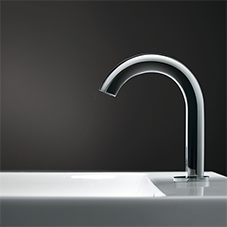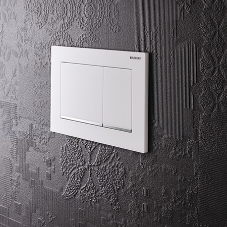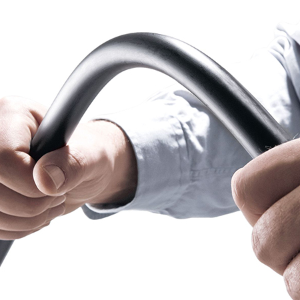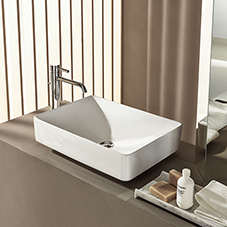What has been the true impact of 12 months of remote working on UK office staff? A recent YouGov poll by bathroom designer and manufacturer Geberit shows a workforce missing their colleagues and longing for a return to face-to-face meetings. With more than half of us missing the work-life balance that the office offers, its findings also reveal very little resistance from staff when faced with the prospect of a return to the office. Here, Sophie Weston, channel marketing manager at Geberit, reveals more about its insight and the impact of hygiene in the office moving forward – especially the washroom.
The true impact of remote working
Let’s rewind twelve months ago to the start of the first nationwide lockdown. How many of us working in the office experienced some initial euphoria or even relief at the prospect of spending more time at home and less on the commute? For many, the prospect of remote working promised a shift towards a better work-life balance, with much written during the spring of 2020 about the positive impact it would have upon staff wellbeing and efficiency. The Guardian reported in March 2020 how, “Covid-19 could permanently shift working patterns as companies forced to embrace remote working by the pandemic find that their employees do not want to return to the office once the closures are lifted“.
There’s no doubt that the ease with which so many of us took to digital communications could have given us every reason to question the need for the office at all. Meetings, conferences, events – you name it – have all been carried out on the likes of Teams or Zoom over the last year. Many firms have taken the step of moving to remote-working on a long term basis, with some big hitters even announcing the permanent closure of offices.
But what’s the view out there from staff? One year on, are employees missing office life – and what do they feel about a possible return to the office? That’s what Geberit wanted to find out when they conducted a YouGov poll of 1,000 British private sector employees. They found that, far from being a workforce enjoying the trappings of remote working, they're experiencing Zoom fatigue, missing their colleagues, communication, collaboration – and even the commute.
Missing office life
The poll of 1,000 British private sector employees, of which 728 worked in an office pre-pandemic, shed a new light on how the majority of us currently view our working life. Readers might be surprised to learn that 39% of those polled reported that, as of February 2021, they were already back in the office in some capacity – and almost a quarter (23%) expect to return to the office this year. Only 8% expect a return date in either 2022 or not to return to the office at all.
When Geberit asked respondents whether they missed any aspects of office life it seems, rather unsurprisingly, those daily interactions were very much missed. Socialising with colleagues, such as coffee breaks or after-work outings, was the most popular feature missed (51%), followed by missing the ease of communication with colleagues (46%). There are clear signs, too, that Zoom fatigue is well and truly setting in, with a third of respondents missing in-person meetings.
In what appears to contradict the view that working remotely during the pandemic could improve the work-life balance, 42% of respondents told us that they missed the ability to better achieve this in the office. This could, perhaps, explain the 8% of us who miss the commute. There are many elements of office life that we’re missing but what about the million-dollar question - how do employees feel about returning to the office when restrictions allow?
Returning to the office?
Geberit asked respondents how willing they would be to return to work– and the response was overwhelmingly clear. More than three quarters (76%) indicated that they would be willing to do so for either some or all of their working hours. And, of those not due to return until later in the year, more than half (51%) reported their current working life had a negative impact on their wellbeing.
This willingness to return is based on firms having in place the correct safety measures and social distancing precautions in place. When questioned further about specific areas of concern in the office, the staff communal toilet or washroom areas were the biggest area of concern. Almost half (47%) had reservations about surfaces and touchpoints in the space, with 37% worried about standards of washroom hygiene. Ventilation (45%), surfaces and touchpoints, this time in the kitchen area, (39%) were also high on the list. The evidence is clear, staff are willing to return but do have some areas of concern.
Addressing concerns
There are two fundamental areas employers need to address and maximising hygiene is definitely one. But the second is an office that not only reinforces the perception of a clean space but one that also offers a reassuring space for employees. Global consulting firm WSP notes the significance of this in a recent report when it stated that, “…if people continue to be the driver for change…businesses will have to provide safe working environments that increase the feelgood factor and ultimately raise productivity and creativity. There’s much that we can learn from this lockdown period to make the workplace better and our interactions with it more effective.” Experts at the firm predict that we could soon see the “hotelization” of office space, as workplaces seek to offer more home comforts, such as plants and soft furnishings, to make spaces more cosy.
Hygiene-led solutions
Above all, hygiene led solutions must lead the way. So, what measures are businesses taking to put hygiene front of mind and reassure staff?
Space has been one of the most important considerations. Geberit's poll showed that 39% were concerned about the distance between desks or overcrowding in the office. Over the last twelve months, many firms have moved away from hot-desking and returned to fixed desk allocation. Meanwhile, much has been made of the end of the open-plan office – perhaps no bad thing in light of a study from Harvard which showed that such spaces made staff less inclined to collaborate and previous studies showing they make employees less productive.
With the washroom area the single biggest area of concern for the respondents, this may be something too that firms need to address, and infra-red and touchless innovations will soon feature more prominently in office design. Manufacturers such as Geberit have been producing touchless products for many years and this focus on hygiene will see a huge shift towards touchless technology in both the private and public spaces. Infra-red wall-mounted taps, for example, such as Geberit’s Brenta and Piave products, optimise hand hygiene in heavy footfall washrooms. Likewise, touchless WC and urinal flush controls incorporate innovations such as a sensor that allows the unit to flush as soon as the toilet or urinal has been used, all minimising the spread of bacteria in high-footfall areas.
But it’s not just infra-red technology that can help put hygiene front-of-mind. Other product developments from manufacturers – for instance, Geberit’s KeraTect® Glaze - make cleaning easier with its virtually non-porous and smoother surface; such glazes can also help prevent staining of the ceramics and create a high-gloss effect. Solutions like this not only help maintain high levels of hygiene but also, crucially, really help to enhance the look and feel of the washroom as a ‘clean’ space, helping to reassure apprehensive staff. Similarly, developments such as Rimfree® toilets and TurboFlush technology can eliminate tricky corners and hard-to-reach areas around the pan, with removable QuickRelease hinge toilet seats also helping eradicate any hidden areas where dust and bacteria may proliferate and reducing cleaning time.
Hygiene in the future?
With the pandemic thrusting hygiene into the spotlight, our relationship with hygiene has clearly changed. Geberit's poll is quite clear - staff are willing to return to the office. But the responsibility is now on firms and manufacturers to work together to find not only hygienically-optimised products, but solutions and designs that also reinforce the perception of a clean space. Doing so will not only reassure employees but ensure they can future-proof the space for a new design era ahead.
Lifting the lid on hygiene in the office [Blog]
| T | (0800) 0778365 |
|---|---|
| F | (0844) 8006604 |
| E | enquiries@geberit.co.uk |
| W | Visit Geberit Sales's website |
| Geberit House, Edgehill Drive, Warwick, CV34 6NH |


![Lifting the lid on hygiene in the office [Blog]](/master-06839388-16-9-570-322-file117543.png)
![Lifting the lid on hygiene in the office [Blog]](/preview-09049918-570-322-file117544.jpg)





